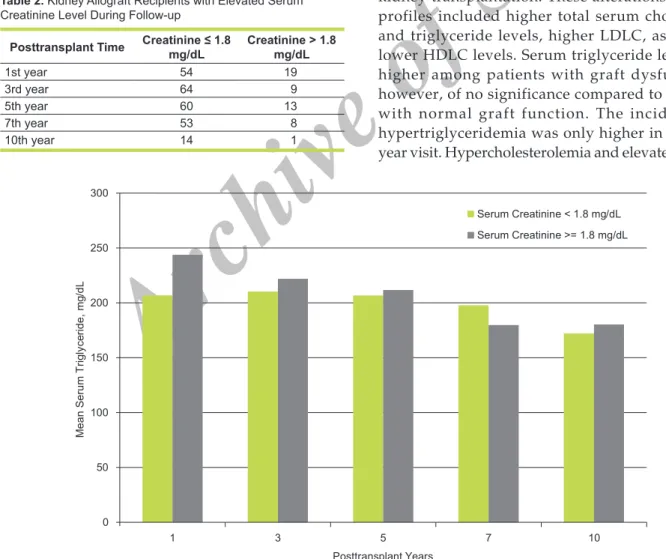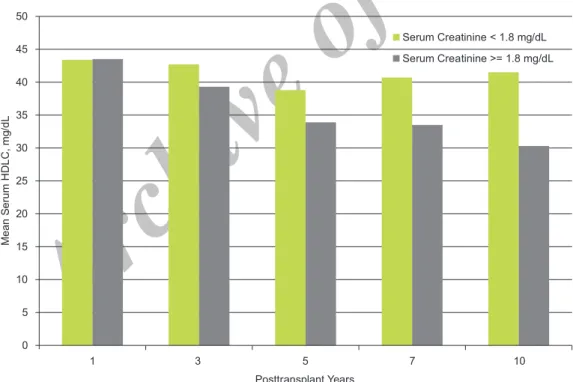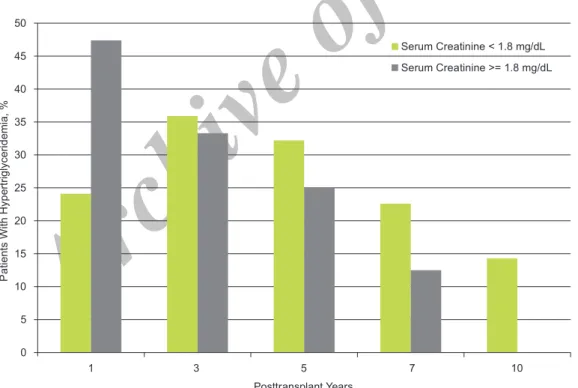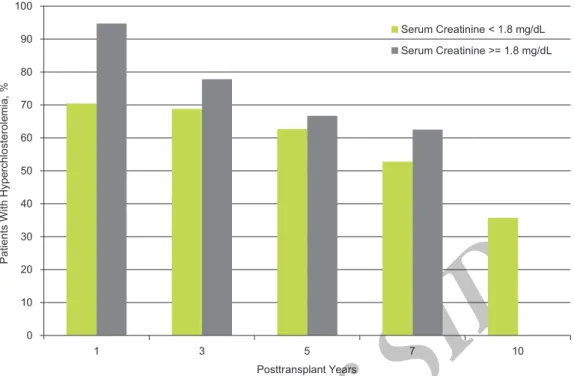Archive of SID
o
riginal
p
aper
Hyperlipidemia After Kidney Transplantation
Long-term Graft Outcome
Ghanbarali Raees-Jalali, Ahad Eshraghian, Alireza Faghihi, Jamshid Roozbeh, Mohammad Mehdi Sagheb,
Hamed Eshraghian, Saeed Behzadi
Introduction. Metabolic complications are common after kidney transplantation and can cause considerable morbidity and even threaten graft function. This study aimed to investigate the prevalence of hyperlipidemia and its impact on graft function in 10 years of follow-up of patients undergoing kidney transplantation.
Materials and Methods. This prospective study was conducted on 73 patients who underwent kidney transplantation between April 1996 and April 1998 to evaluate their lipid profile and graft function as well as the effect of hyperlipidemia in long-term kidney allograft function. Kidney allograft dysfunction was defined as a serum creatinine level greater than 1.8 mg/dL.
Results. The mean serum triglyceride level was higher at 1, 3, 5, and 10 years, but not 7 years, among patients with graft dysfunction in comparison with patients with normal graft function. However, these differences were not significant. The mean serum total cholesterol level was significantly higher in patients with graft dysfunction at 1 year (P = .03). Of the patients with graft dysfunction, 94.7% developed hypercholesterolemia at the first year visit, as compared to 70.4% of patients with normal graft function (P = .03). The frequency of hypercholesterolemia was higher among those with a serum creatinine greater than 1.8 mg/dL at all other visits, but without significant difference.
Conclusions. Hyperlipidemia is common after kidney transplantation, especially in the first year after transplantation. Higher serum total cholesterol levels might be related to graft dysfunction.
IJKD 2012;6:49-55 www.ijkd.org
Department of Internal Medicine, Nemazee Hospital, Shiraz University of Medical Sciences, Shiraz, Iran
Keywords. kidney
transplantation, hyperlipidemia, outcomes
INTRODUCTION
H y p e r l i p i d e m i a i s a k n o w n m e t a b o l i c complication of solid organ transplantation, including kidney transplantation. Although the exact mechanism has not been understood to date, correlations between immunosuppressive regimens such as cyclosporine and steroids and hyperlipidemia have been observed in several studies.1,2 Hyperlipidemia is a major risk factor
for cardiovascular problems that are the main
causes of mortality after kidney transplantation.3
It may also lead to acute graft rejection and development of chronic allograft nephropathy, and thus, deteriorate prognosis of recipients.4,5
Hypercholesterolemia with elevated low-density lipoprotein cholesterol (LDLC) level, associating with immunosuppressive medications, has been the most common reported form of dyslipidemia in short-term studies.1 However, few studies
Archive of SID
among kidney transplant patients. Since the needfor immunosuppressive medications decreases over time, hyperlipidemia may resolve in long-term. Therefore, this study aimed to evaluate the prevalence of hyperlipidemia and its effect on graft function in a 10-year follow-up of kidney transplant recipients.
MATERIALS AND METHODS
Study Population
Between April 1996 and April 1998, 150 adult patients underwent kidney transplantation in Shiraz Organ Transplant Center, Shiraz, Iran. Among them, those with a serum creatinine level exceeding 3 mg/dL, graft survival shorter than 1 year, age less than 18 years old, and limited life expectancy were excluded. We enrolled 73 patients who were eligible to follow them up for 10 years. Immunosuppressive regimens included corticosteroids, cyclosporine, mycophenolate mofetil, tacrolimus, and azathioprine. Acute rejection was treated with methylprednisolone, 0.5 g intravenously for 3 days, and steroid-resistant rejection was treated with antithymocyte globulin.
Data Collection
The following data were recorded at baseline: age and gender of the patients, source of kidney allograft, underlying cause of end-stage renal disease, blood urea nitrogen (BUN), serum creatinine, and serum triglyceride, serum total cholesterol, LDLC, and high-density lipoprotein cholesterol (HDLC). Serum creatinine, BUN, HDLC, LDLC, triglyceride, and total cholesterol were also recorded at the 1st, 3rd, 5th, 7th, 10th posttransplant years. For the purpose of this study, graft dysfunction was defined as a serum creatinine greater than 1.8 mg/dL; hypertriglyceridemia, as a serum triglyceride greater than 250 mg/dL; and hypercholesterolemia, as a serum cholesterol greater than 200 mg/dL. The upper limit of a normal serum LDLC was considered 100 mg/dL and a normal HDLC, 40 mg/dL. Lipid-lowering agents were administered, including atorvastatin, simvastatin, and gemfibrosil, when required during the 10-year follow-up.
Ethics and Consent
This study was approved by ethical committee of Shiraz University of Medical Sciences and all
the patients provided written informed consent regarding the use of their personal information. The study protocol was in accordance with Helsinki declaration as revised by the 42nd World Medical Assembly, Edinburgh, Scotland, 2000.
Statistical Analyses
Statistical analyses were performed using the SPSS software (Statistical Package for the Social Sciences, version 11.0, SPSS Inc, Chicago, Ill, USA). Continuous data were expressed as mean ± standard deviation. Parameter comparisons were performed using the Student t test, and correlation analyses were performed using the Pearson correlation coefficient test. P values less than .05 were considered significant.
RESULTS
A total of 73 patients had complete routine visits to our nephrology clinics. Among these, 43 patients (58.9%) were men and 30 patients (41.1%) were women. The mean age was 36 years in patients with normal graft function and 33 years in patients with allograft dysfunction (P > .05). Twenty six patients (36.1%) were aged between 18 and 30 years, while 47 patients (63.9%) aged between 30 and 60 years at the time of transplantation. Sources of transplanted kidneys are outlined in Table 1. The underlying diseases leading to kidney transplantation were glomerulonephritis in 20 patients, diabetic nephropathy in 13, reflux nephropathy in 10, hypertension in 7, lupus nephritis in 5, Alport syndrome in 5, and unknown in 13. All of these 73 patients completed their follow up visits till the end of the 5th year. At the 7th year, 12 patients and at the 10th year, 58 patients did not continue to have regular visits due to various reasons.
Patients diagnosed with hyperlipidemia were treated with atorvastatin, lovastatin, or gemfibrosil. The number of patients with normal graft function and those who developed graft dysfunction (serum creatinine > 1.8 mg/dL) at each visit interval are
Donor Source Number (%)
Living unrelated 23 (31.5)
Living related 27 (37.0)
Spouse 7 (9.5)
Cadaver 14 (22.0)
Archive of SID
shown in Table 2. The mean serum creatininelevel at 1, 3, 5, 7, and 10 years were 1.63 mg/dL, 1.35 mg/dL, 1.46 mg/dL, 1.56 mg/dL, and 1.46 mg/dL respectively. The mean serum triglyceride levels in 10-year follow-up are shown in Figure 1 by graft function. The mean serum triglyceride level was higher in all 5 visits in patients with graft dysfunction in comparison to patients with normal graft function, except for the 7th year follow-up visit. However, these differences were not significant. The mean serum total cholesterol level was significantly higher in patients with graft dysfunction at the 1st year visit (P = .03). The mean serum total cholesterol levels at each visits in patients with normal graft function and those developed graft dysfunction is shown in Figure 2. No significant correlation was observed between the mean serum HDLC level graft function (Figure 3).
The mean serum LDLC level, however, was higher in patients with graft dysfunction at 1, 3, 5, and 7 years. The differences were significant only in the 1st year visit (P = .03; Figure 4).
No significant difference was noted in the frequency of hypertriglyceridemia between patients with normal graft function and those who developed graft dysfunction (Figure 5). Almost all of the patients (94.7%) with graft dysfunction developed hypercholesterolemia at 1 year compared to 70.4% of patients with normal graft function (P = .03). The frequency of hypercholesterolemia was higher among those with a serum creatinine higher than 1.8 mg/dL at all other visits, but without significant difference (Figure 6).
DISCUSSION
Results of this 10-year prospective study revealed that dyslipidemia was common after kidney transplantation. These alterations in lipid profiles included higher total serum cholesterol and triglyceride levels, higher LDLC, as well as lower HDLC levels. Serum triglyceride level was higher among patients with graft dysfunction, however, of no significance compared to patients with normal graft function. The incidence of hypertriglyceridemia was only higher in the first year visit. Hypercholesterolemia and elevated serum
Posttransplant Time Creatinine ≤ 1.8mg/dL Creatinine > 1.8 mg/dL
1st year 54 19
3rd year 64 9
5th year 60 13
7th year 53 8
10th year 14 1
Table 2. Kidney Allograft Recipients with Elevated Serum Creatinine Level During Follow-up
Archive of SID
LDLC levels were significantly higher only in thefirst year when comparing the two groups. It is important to note that incidence of dyslipidemia decreases over the time after kidney transplantation. Peak incidence of altered lipid profile was also
observed in the first year visit.
There are many studies in the literature about the incidence, prevalence, and influence of hyperlipidemia on graft function after kidney transplantation. Most of them are retrospective
Figure 3. Mean serum high-density lipoprotein cholesterol (HDLC) levels in kidney allograft recipients with normal graft function and patients with graft dysfunction.
Archive of SID
or cross-sectional studies and nearly all of themhave emphasized on the high prevalence of hyperlipidemia after kidney transplantation.1-3 A
1-year longitudinal prospective study was conducted in our transplant center on 93 patients undergoing
kidney transplantation. That study revealed that patients would develop elevated serum cholesterol, triglyceride, and LDLC levels with a peak of mean lipid profile at the 9th month after kidney transplantation. Hypercholesterolemia was the most
Figure 4. Mean serum low-density lipoprotein cholesterol (LDLC) levels in kidney allograft recipients with normal graft function and patients with graft dysfunction.
Figure 5. Hypertriglyceridemia (serum triglyceride > 250 mg/dL) in kidney allograft recipients with normal graft function and patients with graft dysfunction.
Archive of SID
common type of hyperlipidemia among patientswith graft dysfunction.6 Hyperlipidemia was also
common after kidney transplant in another study conducted in Hong Kong by Tse and colleagues.7
This study was conducted retrospectively and lipid profiles of patients were evaluated during 3 years after transplantation. Like our study, the peak incidence of hyperlipidemia was at the first year and incidence rate decreased in the second and third years. Hyperlipidemia was also more common in patients receiving cyclosporine compared to those on tacrolimus as immunosuppressive medication. However, this study did not report the impact of hyperlipidemia on graft function.7
Cardiovascular complications are a leading cause of morbidity and mortality after kidney transplantation.8 Hyperlipidemia along with diabetes
mellitus, smoking, and hyperhomocysteinemia are risk factors for cardiovascular complications following kidney transplantation.9 Thus, diagnosis
and treatment of hyperlipidemia will be of great importance to improve prognosis of recipients. The exact mechanisms and risk factors of hyperlipidemia after transplantation were not well described. Nevertheless, several predisposing factors such as corticosteroids and cyclosporine, pretransplant hypercholesterolemia, weight gain, and thiazide
diuretics were proposed. Very low-density lipoprotein cholesterol turnover rate, fractional clearance of intralipid, and postprandial triglyceride clearance rate are decreased after transplantation all may be in part responsible in hyperlipidemia.10-12
Our study is one of the few studies with a long duration of follow-up. Although at the last visit, ie, the 10th year, most of the patients did not return for follow-up, nearly all of them completed the 7th year visit. Risk factors of hyperlipidemia were not evaluated in this study; however, the impact of hyperlipidemia on graft function was the main focus. It seems that hyperlipidemia in the first year is significantly associated with graft dysfunction. That might be due to administration of lipid-lowering agents in those diagnosed to have elevated serum lipid profile. Other limitations of the present study are the small sample size and use of lipid-lowering agents in the course of study that alters incidence of hyperlipidemia. However, treatment of those with hyperlipidemia was inevitable due to ethical considerations.
CONCLUSIONS
Altered lipid profile is prevalent after kidney transplantation among Iranian patients, especially at the first year posttransplantation. We propose
Figure 6. Hypercholesterolemia (serum total cholesterol > 200 mg/dL) in kidney allograft recipients with normal graft function and patients with graft dysfunction.
Archive of SID
a routine checkup for lipid profile in regular andshort intervals, especially in the first year after transplantation. These intervals may be longer after the first year. Other prospective studies with larger sample sizes and targeting the effect of lipid-lowering agents on the incidence of hyperlipidemia and graft dysfunction seem to be valuable.
CONFLICT OF INTEREST
None declared.
REFERENCES
1. Hricik DE, Mayes JT, Schulak JA. Independent effects of cyclosporine and prednisone on posttransplant hypercholesterolemia. Am J Kidney Dis. 1991;18:353-8. 2. Bastani B, Robinson S, Heisler T, et al. Post-transplant
hyperlipidemia: risk factors and response to dietary modification and gemfibrozil therapy. Clin Transplant. 1995;9:340-8.
3. Lindholm A, Albrechtsen D, Frodin L, Tufveson G, Persson NH, Lundgren G. Ischemic heart disease--major cause of death and graft loss after renal transplantation in Scandinavia. Transplantation. 1995;60:451-7. 4. Isoniemi H, Nurminen M, Tikkanen MJ, et al. Risk
factors predicting chronic rejection of renal allografts. Transplantation. 1994;57:68-72.
5. Stephan A, Barbari A, Karam A, Kilani H, Kamel G, Masri A. Hyperlipidemia and graft loss. Transplant Proc. 2002;34:2423-5.
6. Hamidian Jahromi AR, Raiss-Jalali GA, Malekhosseini A, Jan-Ghorban P. Impact of serum lipid profiles and hypertension on chronic renal allograft dysfunction. Transplant Proc. 2003;35:259-62.
7. Tse KC, Lam MF, Yip PS, Li FK, Lai KN, Chan TM. A long-term study on hyperlipidemia in stable renal transplant recipients. Clin Transplant. 2004;18:274-80.
8. Kasiske BL, Guijarro C, Massy ZA, Wiederkehr MR, Ma JZ. Cardiovascular disease after renal transplantation. J Am Soc Nephrol. 1996;7:158-65.
9. Kruger B, Walberer A, Farkas S, et al. The impact of “high-producer” interleukin-6 haplotypes on cardiovascular morbidity and mortality in a kidney transplant population. Transplant Proc. 2009;41:2539-43.
10. Savdie E, Gibson JC, Crawford GA, Simons LA, Mahony JF. Impaired plasma triglyceride clearance as a feature of both uremic and posttransplant triglyceridemia. Kidney Int. 1980;18:774-82.
11. Chan MK, Persaud JW, Varghese Z, Fernando ON, Moorhead JF. Fat clearances and hyperlipidaemia in renal allograft recipients--the role of insulin resistance. Clin Chim Acta. 1981;114:61-7.
12. Foger B, Konigsrainer A, Palos G, et al. Effect of pancreas transplantation on lipoprotein lipase, postprandial lipemia, and HDL cholesterol. Transplantation. 1994;58:899-904. Correspondence to:
Ahad Eshraghian MD
Department of Internal Medicine, Nemazee Hospital, Shiraz University of Medical Sciences, PO Box: 71345-1744, Shiraz, Iran Tel: +98 711 647 4316 Fax: +98 711 627 6212 E-mail: eshraghiana@yahoo.com Received December 2010 Revised October 2011 Accepted October 2011




